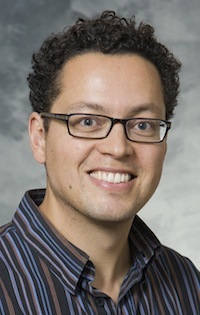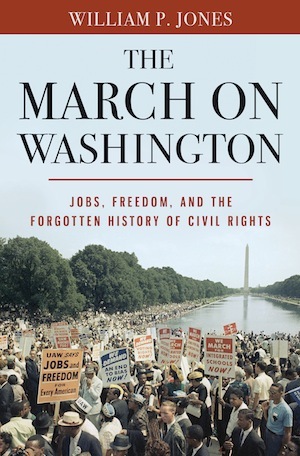Jones book highlights forgotten history of March on Washington
August 28 marks the 50th anniversary of the historic March on Washington, which drew nearly 250,000 to the nation’s capital.
The day is best remembered for the stirring “I Have a Dream” speech by Dr. Martin Luther King Jr., and the impact the nonviolent demonstration that day had on the civil rights movement.

William P. Jones
What is not remembered as well, says University of Wisconsin–Madison history professor William P. Jones, is that the march was as much about economic equality as civil liberties — or that the march actually had its genesis 22 years earlier, at a meeting of the Brotherhood of Sleeping Car Porters, where frustration boiled over from discrimination in the armed forces and among defense contractors.
Jones recounts this forgotten history in his new book, “The March on Washington: Jobs, Freedom, and the Forgotten History of Civil Rights.”
“It struck me that here’s an event that we know a lot about; everybody knows about the March on Washington and Martin Luther King’s ‘I Have a Dream Speech,'” Jones says, “but not the story about the connection to the union movement and the economic perspective of the march and how that was so primary to its development.”
Jones says he initially set out to research black union activists and their relationship to the civil rights movement when he found an archive connected to the Negro American Labor Council, which initiated and organized much of the march.
A. Philip Randolph, the union leader of the sleeping car porters, put out a call in January 1941 for 50,000 black workers to march to Washington under the slogan “We Loyal Negro-American Citizens Demand the Right to Work and Fight for Our Country.”

“Their initial proposal was to march for jobs. They didn’t really connect it to the issues of segregation and voting rights. They were mostly northern union activists, and they expanded their agenda to bring in the movement that Martin Luther King was leading in the South,” Jones says.
King was already a national figure at the time of the march, having gained notoriety during the Montgomery bus boycott eight years earlier and for his leadership during the protests in Birmingham. But King was not the most well-known speaker that day, nor was he considered the leader of the movement at that time, Jones says.
“If you would have asked people in 1963 who the leader of the civil rights movement was, they would have said A. Philip Randolph,” Jones says.
Jones says part of the reason the goal of economic equality has become a footnote to the march is the enduring power of King’s speech.
“It was a remarkable speech, but it actually said very little about the specific goals of the march, and one of the reasons for that is he spoke last and by the time he got up on the podium, the goals of the march had been stated over and over and over again,” he says. “It was the end of a really long day and his job was to kind of provide an inspirational speech to revive people’s spirits. And he did that and, as a result, it was a speech that had a lot of lasting power, but it also detracted from the goals of the march.”
“It struck me that here’s an event that we know a lot about; everybody knows about the March on Washington and Martin Luther King’s ‘I Have a Dream Speech,’ but not the story about the connection to the union movement …”
William P. Jones
King’s famed speech did receive media attention, but it was not a central focus of press coverage and was not regarded as an expression of the primary goals of the march, Jones says.
“King being seen as the singular leader of the movement and the focus on his speech came after his assassination in 1968, partly as a way of simply trying to memorialize him.”
The march did have a significant effect on shifting the attention in Washington to economic issues and had an impact in the War on Poverty, Jones says. He points to the passage of the Civil Rights Act in 1964, which — unlike the bill introduced by President Kennedy a year earlier — included Title VII, which made it illegal for private employers and unions to discriminate on the basis of race.
“For most of the people who participated in the march, that was actually the primary goal: to make employment discrimination illegal,” Jones says.
While the bill did not deliver the organizers’ goal of creating a public works program, it did include increased funding for education, health care and housing, creating a spur of public employment.
“It had a particularly profound effect on African-Americans in big cities, who flocked to those jobs by the mid-1970s,” Jones says. “In that sense, the march didn’t create the War on Poverty, but it shifted it in a really important way.”
“For most of the people who participated in the march, that was actually the primary goal: to make employment discrimination illegal.”
William P. Jones
Major civil rights organizations, including leadership at the NAACP and the Urban League, opposed the idea of a march on Washington. The traditional civil rights standard bearers insisted that the most effective way to bring change was through lobbying and legal challenges.
“They believed that bringing a whole bunch of people to Washington had the potential of creating a violent scene between supporters and opponents,” Jones says. “It had all the potential for bad publicity.”
But organizers felt there was benefit in a massive public demonstration. And they were confident that violence against the nonviolent protesters would provoke sympathy from the public.
Indeed, media coverage leading up to the march focused on the preparations for a violent scene: jails were emptied in anticipation of hordes of protesters getting arrested, troops and helicopters were staged, government agencies and liquor stores closed.
But there was no violence, and the media coverage post-march spoke glowingly of the peaceful demonstrators.
“Just that shift showed the power of this tactic, these sorts of scenes of thousands of people out there acting peacefully was incredibly effective,” Jones says.
